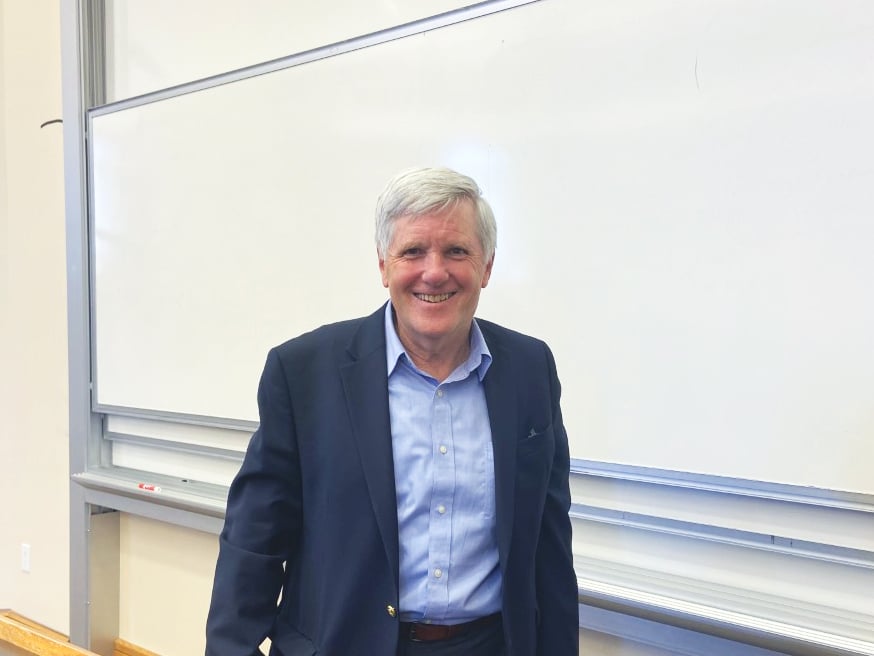David J. Hayes J.D. ’87, a climate policy expert in the Biden administration, discussed the President’s recent steps against climate change at a Tuesday panel hosted by the Stanford Environmental Law Society and the Environmental and Natural Resources Law and Policy Program.
Hayes, a special assistant to the President for climate policy, serves on the National Climate Task Force, a group of 25 Cabinet-level leaders from different governmental agencies who collaborate on implementing climate solutions. The task force focuses on reducing greenhouse gases, accelerating the transition to a clean energy economy and addressing climate adaptation and resilience needs.
The Bipartisan Infrastructure Law, which Congress passed in November, is the main policy that addresses these topics by supplying a record-high $550 billion investment for new infrastructure that addresses climate change.
Hayes, who also served in the Department of the Interior during the Clinton and Obama administrations, said the infrastructure bill marks a development from past administrations: “When we came into the Obama administration, we started to construct a climate agenda. But it wasn’t the priority that it is today,” Hayes said.
Hayes said part of the bill will reduce greenhouse gas emissions by assisting transitions in transportation, power and industrial sectors; these three sectors contribute to 76% of the country’s greenhouse gas emissions. The bill will fund both infrastructures for energy and research. Furthermore, the U.S. General Services Administration will dedicate this increased federal funding to supporting low-carbon materials in public construction.
The funding will “provide an accelerant to an existing market trend [to decarbonise],” Hayes said. Further investment, he said, could further development in a variety of fields, ranging from electric vehicle charging stations and railways to clean hydrogen.
The bill also allocates about $10 billion to carbon reduction and removal technologies, with priority given to developing direct air capture facilities and growing interest in natural-based carbon sinks, such as forestry.
Hayes hesitated to endorse carbon pricing, a policy that would standardize prices and create a market to trade carbon emissions across the US. Such a policy is “not part of our political reality right now,” he said. Instead, the administration will focus on regulatory policy and financial and tax incentives to nudge the private sector towards investing in technology to enable a transition in these sectors.
While Hayes acknowledged that agriculture is also a significant contributor to greenhouse gas emissions, climate-smart agricultural practices and livestock remain “an area with lousy data.” In response to this, Hayes said a set of proposed climate-smart agricultural practices will be trialed through the Climate-Smart Commodity Program.
“We built into it measurement, monitoring, verification and reporting, so that we get the data to see if these practices are in fact good, and how much they should be valued,” he said.
And when it comes to transitioning to clean energy, the frontrunner in renewable energy generation is offshore wind turbines, Hayes said. He gave New Jersey and other progressive east coast states’ active investment in offshore wind energy generation as an example of how state-level climate commitments generate the political will to deploy these policies. He is hopeful that the Build Back Better bill — a financial package proposed in 2021 that establishes programs for education, labor, childcare, healthcare, taxes, immigration, and the environment — will eventually provide further funding from tax credits to support solar, wind and nuclear power plants.
Law students raised concerns about the feasibility of long-distance transmission of renewable energy sources, which face challenging cost-allocation across states despite their potential to decarbonise the grid across the country.
According to Hayes, about $10 billion of the infrastructure bill is dedicated to transmission lines. He said some renewable energy resources are “stranded,” such as the Wyoming wind farms that are potentially decarbonising West Coast’s electrical grid, and transmission lines could help neighboring states that don’t have renewable sources. The fund will be used to invest in expensive infrastructure, as well as to research how stakeholders can share the cost and liability for transmission line projects, as different financial and legal frameworks have deterred interstate cooperation in the past, according to Hayes.
“A lot of these [transmission projects] have been in the works for years,” Hayes said. “We’re trying to get them over the finish line here when we’re in office.”
The government is already bearing the financial cost of the effects of climate change. Through extreme weather events, wildfires, and other disasters, the federal government spent around $145 billion in 2021 to remedy the damages from the biggest 20 disasters alone. A portion of the bill is dedicated to developing climate adaptation solutions for climate resilience, such as an increase in long-term (instead of seasonal) contracts for firefighters.
Hayes said equity is a focus of the Biden administration’s approach to climate solutions: “There is a recognition that our fossil fuel-based economy has really hurt a lot of disadvantaged communities,” said Hayes, referring to how lower-income communities near the industrial sector and highways disproportionately experience life-threatening air pollution.
Hayes said that while there is momentum for climate action following the passing of the bill and Biden’s commitment to reduce emissions at COP26, challenges remain for implementing long-term mandates.
“The carrots and sticks and the statutory constructs around energy and environment generally haven’t been built up at all with climate in mind,” Hayes said. “We’re creating new approaches under existing statutes — kind of clunky, big litigation risk — particularly with conservative judges.” He also added that the political will of states will continue to be the key driver to supporting climate transitions, regardless of the changing political dynamics at the federal level.
Still, Hayes says he is optimistic about the climate progress that will be achieved in the near future.
“We just passed $1.3 trillion in infrastructure money, a lot of which is going to help the climate,” he said.
